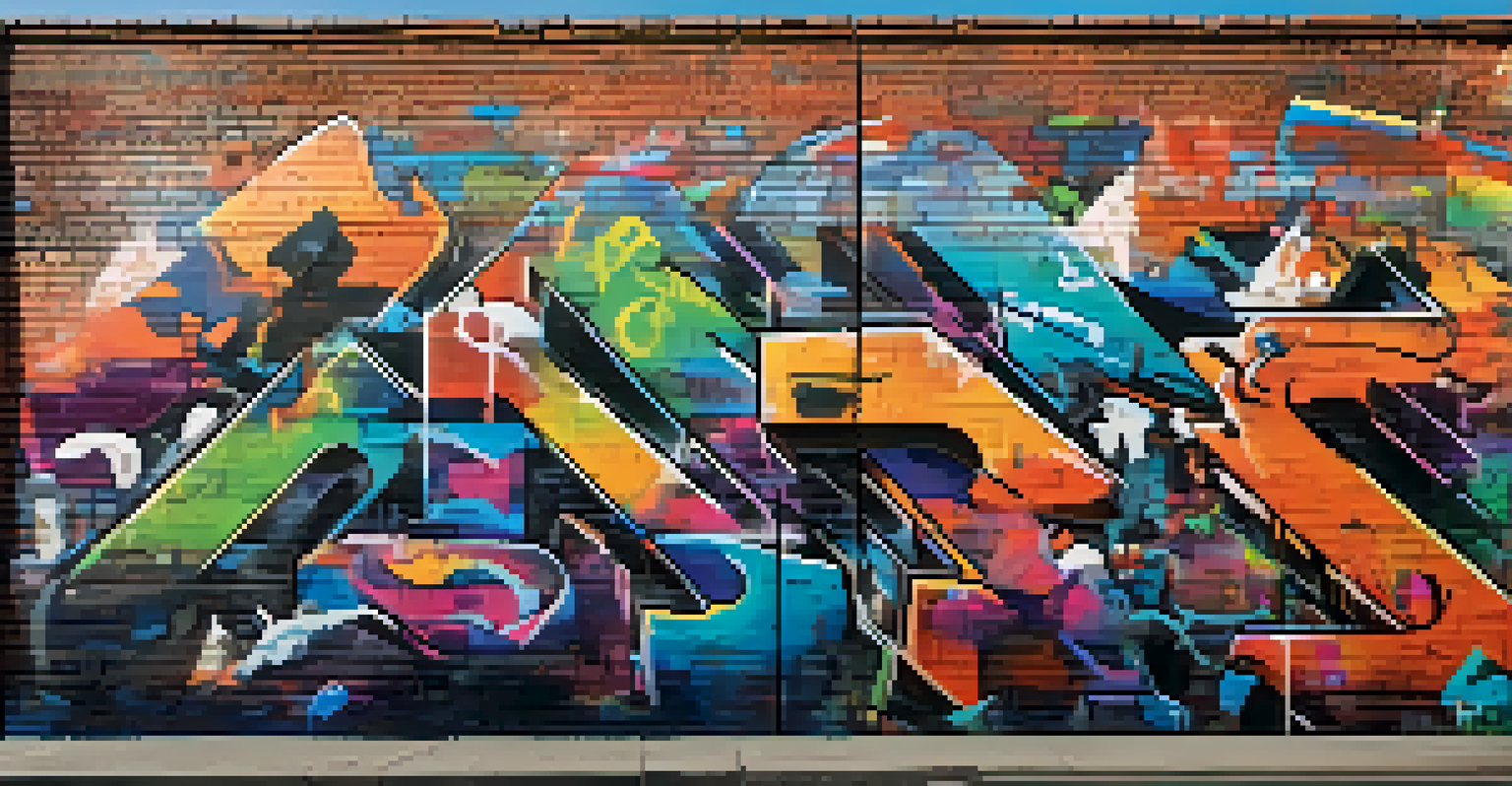Art Movements and Their Impact on Critique and Analysis

Understanding Art Movements: A Brief Overview
Art movements are distinct periods characterized by shared styles, techniques, and philosophies. Each movement reflects the cultural, political, and social contexts of its time. For instance, the Impressionist movement, which emerged in the late 19th century, prioritized capturing light and everyday moments, contrasting sharply with the rigid realism that preceded it.
Every artist dips his brush in his own soul, and paints his own nature into his pictures.
These movements not only influence the creation of art but also shape the way critics and audiences interpret and analyze works. By understanding the defining features of a movement, viewers can engage more deeply with the art. This engagement fosters a richer dialogue between the artwork and its audience, laying the groundwork for meaningful critique.
As art continues to evolve, so too do the movements that emerge. Each new wave builds upon or reacts against previous styles, creating a dynamic interplay that keeps the art world vibrant and relevant. This continuous evolution is crucial for both artists and critics, offering fresh perspectives and insights.
The Role of Impressionism in Art Critique
Impressionism marked a significant shift in how art was perceived and critiqued. Instead of focusing on traditional techniques and subjects, Impressionists celebrated spontaneity and personal expression. This radical departure from the norm prompted critics to reconsider their evaluation criteria, giving rise to new ways of analyzing art.

Critics like Louis Leroy famously coined the term 'Impressionism' as a critique, which ironically became a badge of honor for the artists involved. This highlights how critiques can evolve from negative to positive, shaping the legacy of an entire movement. The dialogue between artists and critics became a vital part of the Impressionist narrative, influencing future movements.
Art Movements Shape Critique
Art movements influence how critics analyze and interpret works, fostering a richer dialogue between the audience and the artwork.
Furthermore, Impressionism paved the way for modern art critiques that embrace subjectivity. Instead of seeking objective truths in art, critics began to explore individual interpretations and emotional responses. This shift enriched the critique process, encouraging a more personal connection between the viewer and the artwork.
Cubism: A New Lens for Analysis
Cubism, pioneered by artists like Pablo Picasso and Georges Braque, revolutionized the way we analyze form and perspective. By breaking objects into geometric shapes and presenting multiple viewpoints simultaneously, Cubism challenged traditional notions of representation. This radical approach necessitated a rethinking of how art could be critiqued.
Art is not freedom from discipline, but disciplined freedom.
Critics were forced to adapt their language and frameworks to address the complexities of Cubist works. They began to focus on the interplay of shapes and colors, rather than the subjects depicted. This shift allowed for a deeper exploration of the relationship between form and meaning, making the analysis of Cubist art a fascinating endeavor.
Moreover, Cubism's influence extended beyond visual art; it impacted literature, music, and architecture. As critics began to draw connections between these disciplines, the conversation surrounding Cubism expanded, enriching the overall critique landscape. This cross-pollination of ideas continues to inspire contemporary analysis in various artistic realms.
Surrealism: Challenging Reality in Critique
Surrealism emerged as a response to the rationalism of the early 20th century, seeking to explore the unconscious mind and dream states. This movement encouraged artists to create works that defied logic, prompting critics to rethink their approaches. Surrealist artworks, with their bizarre juxtapositions, demanded a more interpretive and psychological lens in critique.
Critics began to explore the symbolism and personal narratives behind surrealist pieces, leading to a richer understanding of the artists' intentions. This focus on the subconscious opened up discussions about the nature of reality and how it can be represented in art. The surrealists' quest for deeper truths pushed critiques beyond surface-level analysis.
Impressionism Redefines Evaluation
The Impressionist movement transformed art critique by introducing personal expression and spontaneity as key evaluation criteria.
The impact of Surrealism on art critique persists today, as contemporary critics continue to explore the intersection of reality and imagination. This movement has taught us that art can serve as a gateway to understanding human psychology and societal issues. The layers of meaning in Surrealist art invite ongoing exploration and debate.
Modernism: Redefining Artistic Value
Modernism emerged as a reaction to traditional values, emphasizing innovation and experimentation in art. As artists sought to break away from established norms, critics had to adapt their frameworks to appreciate this new approach. Modernist works often challenged conventions, prompting a reevaluation of what constituted artistic value.
Critics began to embrace abstraction, minimalism, and conceptual art, focusing on the ideas and processes behind the work rather than just the final product. This shift allowed for a broader understanding of art's purpose and significance, transforming critique into a more philosophical endeavor. The criteria for evaluating art became more inclusive and diverse.
Modernism's legacy remains influential in contemporary art critique, as it encourages open-mindedness and acceptance of varied artistic expressions. Today's critics draw on the principles established by Modernists, fostering a space where innovation is celebrated. This ongoing evolution of critique reflects the dynamic nature of the art world.
Postmodernism: Embracing Complexity in Analysis
Postmodernism emerged as a response to Modernism, questioning the idea of a singular truth or narrative in art. This movement celebrates diversity, contradiction, and complexity, leading critics to adopt more multifaceted approaches in their analysis. Rather than seeking definitive meanings, postmodern critiques often explore the interplay of various interpretations.
Critics are now tasked with navigating a landscape filled with irony, pastiche, and self-referentiality. This complexity requires a deeper engagement with the context in which art is created and consumed. By acknowledging the influence of culture, politics, and technology on art, critics can provide more nuanced perspectives.
Street Art Challenges Legitimacy
Street art's emergence has prompted critics to reevaluate the boundaries of artistic legitimacy and its role in social activism.
Furthermore, postmodernism invites discussions about the role of the viewer in the critique process. The recognition that audiences bring their own experiences and biases to art analysis enriches the conversation. This collaborative approach fosters a dynamic relationship between artists, critics, and audiences, emphasizing the importance of diverse viewpoints.
The Impact of Street Art on Contemporary Critique
Street art has gained significant prominence in recent years, challenging traditional notions of where art belongs. By taking art out of galleries and into public spaces, street artists have redefined the parameters of artistic legitimacy. This shift has forced critics to reconsider their approaches, as they navigate the blurred lines between vandalism and legitimate art.
Critics now explore the social and political messages embedded in street art, recognizing its role as a form of activism. This focus on context adds depth to the critique process, inviting discussions about power dynamics and community engagement. Street art has become a powerful medium for addressing contemporary issues, making it a compelling subject for analysis.

Moreover, the rise of social media has transformed how street art is shared and critiqued. Images can go viral, allowing for instant feedback and discussion, which influences the trajectory of both artists and critics. This immediacy creates a dynamic interplay, showcasing how modern critiques evolve in response to the changing landscape of art.
Conclusion: The Ever-Evolving Nature of Art Critique
Art movements serve as catalysts for change, shaping the way we critique and analyze artistic expressions. From Impressionism to Street Art, each movement offers unique insights that challenge our perceptions and broaden our understanding. As critics adapt their approaches to accommodate new styles, the dialogue surrounding art becomes richer and more diverse.
The evolution of art critique reflects broader societal shifts, highlighting the interconnectedness of culture, politics, and creativity. By embracing this complexity, critics can foster deeper connections between art and its audiences, enhancing the overall experience. This ongoing exploration invites us to engage with art in meaningful ways, encouraging personal interpretations.
Ultimately, the impact of art movements on critique and analysis is profound, reminding us that art is not static; it is a living conversation. As we continue to witness the emergence of new movements, the relationship between artists, critics, and audiences will only grow stronger. This vibrant exchange ensures that art remains a relevant and transformative force in our lives.